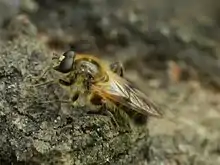| Brachypalpus valgus | |
|---|---|
 | |
| Brachypalpus valgus Olsztyn, Poland | |
| Scientific classification | |
| Domain: | Eukaryota |
| Kingdom: | Animalia |
| Phylum: | Arthropoda |
| Class: | Insecta |
| Order: | Diptera |
| Family: | Syrphidae |
| Subfamily: | Eristalinae |
| Tribe: | Milesiini |
| Subtribe: | Xylotina |
| Genus: | Brachypalpus |
| Species: | B. valgus |
| Binomial name | |
| Brachypalpus valgus | |
| Synonyms | |
| |
Brachypalpus valgus is a species of hoverfly found in Europe.[11]
Description
External images Brachypalpus are medium-sized (wing length 8.5-10.75 mm.) blackish flies with clouded wings. In Brachypalpus valgus the thorax and scutellum are unstriped and aeneous black. The abdominal tergites are shining black with red lateral colour at base of abdomen. Hairs on the body surface are sand brown. Hind trochanters with a posterior process. Hind tibiae slightly curved.[12] [13][14][15] The larva is illustrated by Rotheray (1993).[16]
Mimicry
Superficially resembles a honey bee.
Distribution
Brachypalpus valgus is a Palearctic species with a limited distribution in Europe[17] South Fennoscandia to the Pyrenees then Ireland east through central Europe and northern Italy to Yugoslavia and European parts of Russia.[18]
Biology
Occurs in wooded areas (over-mature Fagus and Quercus forest with senile trees and fallen, rotting timber) where it is a bioindicator. The "short-tailed" larvae have been found in the rotten wood of trees, and under the bark. Males have a rapid, zigzag flight over the trunks of fallen tree. They fly with a high-pitched buzz. The female can be found investigating fallen trees. Both sexes visit the flowers of umbellifers, Berberis, Crataegus, Photinia, Prunus and Sorbus.[19][20]
The flight period is from the end May to the end of June.
References
- 1 2 Panzer, G.W.F. (1797). Favnae insectorvm Germanicae initia oder Devtschlands Insecten. H. 54. Nurnberg [= Nuremberg]: Felsecker. pp. 24 pp., 24 pls.
- ↑ Fallen, C.F. (1816). Syrphici Sveciae. Lundae [= Lund]: Berlingianis. pp. 1–30.
- ↑ Macquart, P. J. M. (1834). Histoire Naturelle des insectes. Dipteres. Tome premiere. Paris: Roret. pp. 578 + 8 pp., 12 pls.
- ↑ Walker, F. (1849). List of the specimens of dipterous insects in the collection of the British Museum. Part III. London: British Museum (Natural History). pp. 485–687.
- ↑ Schiner, Ignaz Rudolph (1860). "Fauna Austriaca". Theil I. Heft (3/4): 185–368.
- ↑ Egger, Johann (1860). "Fortsetzung der Beschreibung neuer Zweiflugler und diagnostische Bemerkungen". Verhandlungen der Kaiserlich-Königlichen Zoologisch-Botanischen Gesellschaft in Wien. 10: 663–668. Retrieved 25 July 2021.
- ↑ Schiner, Ignaz Rudolph (1857). "Diptera Austriaca. Aufzahlung aller im Kaiserthume Oesterreich bisher aufgefundenen Zweiflugler. III. Die osterreichischen Syrphiden". Verhandlungen des Zoologisch-Botanischen Vereins in Wien. 7: 279–506. Retrieved 10 July 2021.
- ↑ Gravenhorst, J.L.C. (1807). Vergleichende Uebersicht des Linneischen und einiger neuern zoologischen Systeme. Goettingen: Dieterich. pp. xvi + 476 pp.
- ↑ Stephens, James Francis (1846). "Illustrations of British Entomology; or, a Synopsis of indigenous insects; containing their generic and specific distinctions; with an account of their metamorphoses, timef appearance, localities, food, and economy, as far as practicabs ole. Supplement". vi + 32: vi + 32. Retrieved 25 July 2021.
- ↑ Macquart, P.J.M. Insectes diptères du nord de la France. Syrphies. Vol. 1829. Lille: "1827". pp. 223 pp., 4 pls. Retrieved 16 July 2021.
- ↑ Stubbs, Alan E. & Falk, Steven J. (1983). British Hoverflies: An Illustrated Identification Guide (2nd (revised) ed.). British Entomological & Natural History Society. p. 271, xvpp. ISBN 0-9502891-3-2.
- ↑ Van Veen, M. (2004) Hoverflies of Northwest Europe: identification keys to the Syrphidae. 256pp. KNNV Publishing, Utrecht.
- ↑ Van Veen, M.P. (2004). Hoverflies of Northwest Europe, Identification Keys to the Syrphidae (hardback). Utrecht: KNNV Publishing. p. 254. ISBN 90-5011-199-8.
- ↑ Bei-Bienko, G.Y. & Steyskal, G.C. (1988) Keys to the Insects of the European Part of the USSR, Volume V: Diptera and Siphonaptera, Part I. Amerind Publishing Co., New Delhi. ISBN 81-205-0080-6.
- ↑ Coe, R.L. (1953) Diptera: Syrphidae. Handbks.ident.Br.insects, 10(1): 1-98. R.ent.Soc.London. pdf Archived 2018-10-04 at the Wayback Machine
- ↑ Rotheray G., 1993 Colour Guide to Hoverfly Larvae Diptera, Syrphidae in Britain and Europe Dipterists Forum pdf Archived 2019-04-03 at the Wayback Machine
- ↑ Fauna Europaea
- ↑ Peck, L.V. (1988) Syrphidae. In: Soos, A. & Papp, L. (eds.) Catalogue of Palaearctic Diptera, 8: 11-230. Akad. Kiado, Budapest.
- ↑ de Buck, N. (1990) Bloembezoek en bestuivingsecologie van Zweefvliegen (Diptera, Syrphidae) in het bijzonder voor België. Doc. Trav. IRSNB, no. 60, pp. 1-167.
- ↑ Speight, M.C.D. (2011). "Species accounts of European Syrphidae (Diptera)" (PDF). Syrph the Net, the Database of European Syrphidae. 65: 285pp.